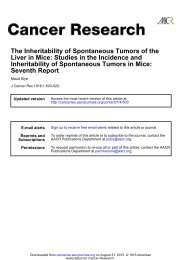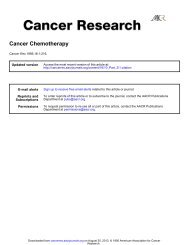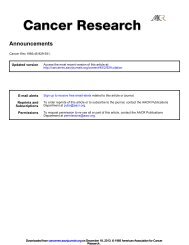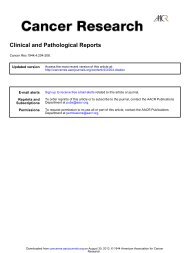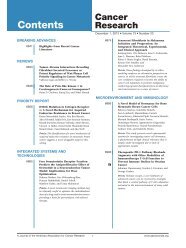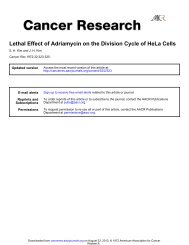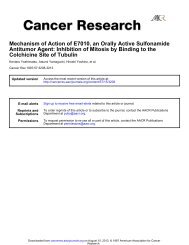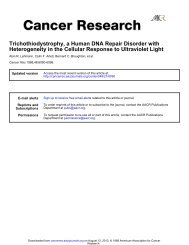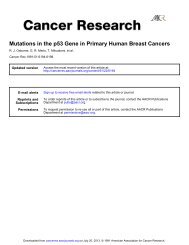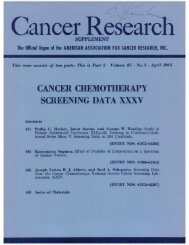Isolation and Characterization of a Hepatoma ... - Cancer Research
Isolation and Characterization of a Hepatoma ... - Cancer Research
Isolation and Characterization of a Hepatoma ... - Cancer Research
You also want an ePaper? Increase the reach of your titles
YUMPU automatically turns print PDFs into web optimized ePapers that Google loves.
<strong>Isolation</strong> <strong>and</strong> <strong>Characterization</strong> <strong>of</strong> a <strong>Hepatoma</strong>-associated<br />
Abnormal (Des- γ-carboxy)prothrombin<br />
Howard A. Liebman<br />
<strong>Cancer</strong> Res 1989;49:6493-6497.<br />
Updated version<br />
Access the most recent version <strong>of</strong> this article at:<br />
http://cancerres.aacrjournals.org/content/49/23/6493<br />
E-mail alerts Sign up to receive free email-alerts related to this article or journal.<br />
Reprints <strong>and</strong><br />
Subscriptions<br />
Permissions<br />
To order reprints <strong>of</strong> this article or to subscribe to the journal, contact the AACR Publications<br />
Department at pubs@aacr.org.<br />
To request permission to re-use all or part <strong>of</strong> this article, contact the AACR Publications<br />
Department at permissions@aacr.org.<br />
Downloaded from<br />
cancerres.aacrjournals.org on July 30, 2013. © 1989 American Association for <strong>Cancer</strong> <strong>Research</strong>.
[CANCER RESEARCH 49, 6493-6497, December I, 1989]<br />
<strong>Isolation</strong> <strong>and</strong> <strong>Characterization</strong> <strong>of</strong> a <strong>Hepatoma</strong>-associated Abnormal (Des-7carboxy)prothrombin1<br />
Howard A. Liebman<br />
William B. Cosile llematology <strong>Research</strong> Laboratory, Division <strong>of</strong> Hematology-Oncology, Boston City Hospital, <strong>and</strong> Boston University School <strong>of</strong> Medicine,<br />
Boston, Massachusetts 02118<br />
ABSTRACT<br />
<strong>Hepatoma</strong>-associated abnormal (des-7-carboxy)prothrombin (HAPT)<br />
is a newly described tumor marker for hepatocellular carcinoma. 11Al' I<br />
has been measured in the blood <strong>of</strong> patients with hepatoma by immunoassay<br />
but has not been isolated or characterized. This paper describes the<br />
quantitative isolation <strong>and</strong> structural characterization <strong>of</strong> HAPT. Purified<br />
HAPT has the same molecular weight, amino-terminal sequence, <strong>and</strong><br />
amino acid analysis (exclusive <strong>of</strong> 7-carboxyglutamic acid) as native<br />
prothrombin <strong>and</strong> abnormal prothrombin isolated from the blood <strong>of</strong> pa<br />
tients taking sodium warfarin. 11API' is heterogeneous in 7-carboxyglu<br />
tamic acid (Gla) content with an average <strong>of</strong> 5 Gla residues/molecule<br />
compared to 10 Cla residues for native prothrombin <strong>and</strong> 2 Gla residues<br />
for abnormal prothrombin. HUM is glycosylated in a manner equivalent<br />
to that for native prothrombin when evaluated by a concanavalin Abinding<br />
assay. These studies find structural identity between 11\ P'l <strong>and</strong><br />
abnormal prothrombin. Therefore the findings support the hypothesis<br />
that HAPT results from an acquired defect in the posttranslational<br />
vitamin K-dependent carboxylation <strong>of</strong> the prothrombin precursor <strong>and</strong> not<br />
an intrinsic defect in the prothrombin precursor molecule.<br />
INTRODUCTION<br />
Prothrombin is the major vitamin K-dependent blood coag<br />
ulation protein synthesized by the liver (1). In the presence <strong>of</strong><br />
sufficient quantities <strong>of</strong> vitamin K, 10 NH2-terminal glutamic<br />
acid residues undergo a posttranslational 7-carboxylation (2-<br />
4). The resulting Gla2 residues confer metal-binding properties<br />
essential for functional activity (5). In the absence <strong>of</strong> vitamin K<br />
or in the presence <strong>of</strong> vitamin K antagonists, the vitamin Kdependent<br />
carboxylase activity in the liver is inhibited <strong>and</strong> des•y-carboxyforms<br />
<strong>of</strong> prothrombin (abnormal prothrombin) are<br />
released into the blood (6, 7). The abnormal prothrombin<br />
cannot bind metal ions <strong>and</strong> is devoid <strong>of</strong> functional activity.<br />
Conformation-specific antibodies against these abnormal forms<br />
<strong>of</strong> prothrombin have been developed <strong>and</strong> can be used to quantitate<br />
the levels <strong>of</strong> abnormal prothrombin antigen in blood (8,<br />
9).<br />
We have reported that abnormal prothrombin antigen is<br />
increased in the blood <strong>of</strong> patients with hepatocellular carcinoma<br />
(10). Abnormal prothrombin antigen in these patients is not<br />
due to vitamin K deficiency since it did not disappear with<br />
parenteral vitamin K. The abnormal prothrombin antigen was<br />
eliminated or reduced with tumor resection or with chemother<br />
apy supporting the primary role <strong>of</strong> the hepatoma in the synthe<br />
sis <strong>of</strong> this antigen. These findings suggest that abnormal pro<br />
thrombin antigen may be a useful new serum marker <strong>of</strong> primary<br />
hepatocellular carcinoma. Subsequently, other investigators<br />
have confirmed these findings using different assay systems<br />
(11-13).<br />
Received 5/2/89; revised 8/28/89: accepted 9/6/89.<br />
The costs <strong>of</strong> publication <strong>of</strong> this article were defrayed in part by the payment<br />
<strong>of</strong> page charges. This article must therefore be hereby marked adverlisenn'nìin<br />
accordance with 18 U.S.C. Section 17.14solely to indicate this fact.<br />
1This work was supported by grants from the American <strong>Cancer</strong> Society (PDT-<br />
256) <strong>and</strong> the NIH (I R29 HL .Ì9C65).<br />
J The abbreviations used are: Gla. vcarboxyglutamicacid; NPT. human name<br />
prothrombin; APT. abnormal prothrombin; TBS. 0.05 M Tris-0.15 M NaCI. pH<br />
7.4; HAPT. hepatoma-associated abnormal (des-vcarboxy) prothrombin: HPLC.<br />
high performance liquid Chromatograph)-.<br />
6493<br />
While the abnormal prothrombin antigen in these patients is<br />
assumed to be similar to abnormal prothrombin in the plasma<br />
<strong>of</strong> patients treated with warfarin, the hepatoma-associated ab<br />
normal prothrombin antigen has not been purified from the<br />
blood <strong>of</strong> patients with hepatoma to demonstrate a structural<br />
relationship. I have now quantitatively isolated <strong>and</strong> character<br />
ized a hepatoma-associated abnormal prothrombin from the<br />
malignant ascites <strong>of</strong> a patient. Analysis <strong>of</strong> this protein demon<br />
strates structural identity with the partially carboxylated non<br />
functional prothrombin species isolated from the blood <strong>of</strong> pa<br />
tients taking sodium warfarin. These studies further support<br />
the hypothesis that abnormal prothrombin in the blood <strong>of</strong><br />
patients with hepatocellular carcinoma is secondary to a defect<br />
in the vitamin K-dependent carboxylation system in the pa<br />
tient's tumor.<br />
MATERIALS AND METHODS<br />
Protein Preparation. NPT was purified by barium citrate absorption,<br />
DEAE-Sephacel chromatography, <strong>and</strong> dcxtran sulfate chromatography<br />
using st<strong>and</strong>ard methods (14. 15). In later experiments, human native<br />
prothrombin was isolated directly from plasma on a column <strong>of</strong> antiprothrombin:Ca(Il)<br />
antibodies by modification <strong>of</strong> methods published<br />
previously (16, 17). APT was prepared by the method <strong>of</strong> Blanchard et<br />
al. (9).<br />
HAPT was purified from patient ascites fluid by ion-exchange chro<br />
matography <strong>and</strong> immunoaffinity chromatography (17). Approximately<br />
500 ml <strong>of</strong> ascites fluid collected in 3 mM EDTA was made 1 m.M<br />
diisopropylphosph<strong>of</strong>luoride <strong>and</strong> 1 mM benzamidine. The ascites fluid<br />
was then dialyzed at 4°Covernight against 0.1 M potassium phosphate,<br />
pH 7.5, containing 1 mM benzamidine. Prothrombin species were<br />
purified by ion-exchange chromatography using a DEAE-Sephacel A-<br />
50 column (3x8 cm) equilibrated with 0.1 M potassium phosphate,<br />
pH 7.5. containing 1 mM benzamidine. Dialyzed ascites fluid, after<br />
centrifugation. was applied to the column, <strong>and</strong> the column was washed<br />
exhaustively with the equilibration buffer. Bound protein was eluted<br />
with 0.5 M potassium phosphate. pH 7.5, containing 1 mM benzami<br />
dine. The eluate was pooled, made 1 mM in diisopropylphosph<strong>of</strong>luoride.<br />
<strong>and</strong> dialyzed at 4°Covernight against 0.1 M boric acid-1 M NaCI-1 mM<br />
benzamidine-0.1% Tween 20, pH 8.5.<br />
The prothrombin species were purified by immunoafTinity chroma<br />
tography. The eluate from the DEAE column was applied to an antiprothrombin<br />
antibody-Sepharose column (1x5 cm) <strong>and</strong> the column<br />
was washed with 0.1 M boric acid-1 M NaCl-1 mM benzamidine-0.1%<br />
Tween 20. pH 8.5. Bound prothrombin was eluted with 4 M guanidine-<br />
HC1 <strong>and</strong> then immediately pooled <strong>and</strong> dialyzed at 4°Cagainst 0.05 M<br />
Tris-0.5 M NaCI-1 HIMbenzamidine-HCl-0.01% Tween 20, pH 7.5. An<br />
anti-prothrombin:Ca(II) antibody-Sepharose affinity column was then<br />
used to remove contaminating fully carboxylated native prothrombin<br />
(16, 17). After dialysis, the prothrombin species were made 5 mM<br />
CaC12 <strong>and</strong> applied to the anti-prothrombin:Ca(II) antibody-Sepharose<br />
column equilibrated with TBS-5 mM CaCI2. The HAPT did not bind<br />
to the column <strong>and</strong> was collected in the flow-through. The small quan<br />
tities <strong>of</strong> contaminating native prothrombin were eluted from the column<br />
with 10 mM EDTA.<br />
Immunoassays <strong>and</strong> Coagulation Assays. Total prothrombin antigen,<br />
fully carboxylated native prothrombin antigen, <strong>and</strong> abnormal pro<br />
thrombin antigen were measured by radioimmunoassays as described<br />
previously (8, 9). The calcium-dependent prothrombin coagulant activ-<br />
Downloaded from<br />
cancerres.aacrjournals.org on July 30, 2013. © 1989 American Association for <strong>Cancer</strong> <strong>Research</strong>.
CHARACTERIZATION OF A HEPATOMA ABNORMAL PROTHROMBIN<br />
ity was assayed by measuring the acceleration <strong>of</strong> the clotting <strong>of</strong> prothrombin-deficient<br />
plasma using Stypven to initiate coagulation (9).<br />
The activation <strong>of</strong> prothrombin <strong>and</strong> HAPT to thrombin in the absence<br />
<strong>of</strong> calcium was performed using the Echis carinólas venom assay (7).<br />
Protein concentrations <strong>of</strong> prothrombin <strong>and</strong> HAPT were determined<br />
spectrophotometrically at 280 nm using an E^,inm„m<strong>of</strong> 14.4 (16).<br />
Analytical Electrophoresis. Polyacrylamide gel electrophoresis in the<br />
presence <strong>of</strong> dodecyl sulfate was performed on prothrombin, abnormal<br />
prothrombin, <strong>and</strong> HAPT using 10% acrylamide gels (18). Proteins were<br />
reduced using 2-mercaptoethanol. Electrophoretic analysis <strong>of</strong> the het<br />
erogeneity <strong>of</strong> the partially carboxylated prothrombin species in the<br />
HAPT was performed using 1251 radiolabeled proteins <strong>and</strong> disc gel<br />
electrophoresis (19) in the presence <strong>of</strong> 8 mM CaC12 as described by<br />
Borowski (17). Native prothrombin, abnormal prothrombin, <strong>and</strong><br />
HAPT were radiolabeled with Nal251 by the lactoperoxidase method<br />
(20). Electrophoresis was performed on the tube gels with a 7.6%<br />
acrylamide, 0.3% bisacrylamide resolving gel <strong>and</strong> a 1.8% acrylamide-<br />
0.22% bisacrylamide stacking gel. Gels, buffers, <strong>and</strong> samples were made<br />
8 mM in CaCl2. After electrophoresis the gels were sliced into 1-mm<br />
fragments <strong>and</strong> counted for 1251 in a Beckman Gamma 8000 scintilla<br />
tion spectrometer.<br />
Ammo-terminal Sequence <strong>and</strong> Amino Acid Analysis. The amino<br />
terminal sequence <strong>of</strong> HAPT was determined by automated Edman<br />
degradation using a Beckman 8900 spinning cut sequenator equipped<br />
with a cold trap. The phenylthiohydantoin derivatives were analyzed<br />
on a Waters HPLC using a Waters C18-/iBondapak column with an<br />
ethanol gradient in ammonium acetate, pH 5.1 (21).<br />
Amino acid analysis was performed on a Beckman model 119CL<br />
amino acid analyzer equipped with a Beckman model 126 data system.<br />
Proteins were hydrolyzed in 6 MHC1 at 110°Cfor 24 h. For quantitation<br />
<strong>of</strong> Gla, the proteins were hydrolyzed in 2 M KOH for 22 h at 110°C<br />
(17, 22). The Gla composition was quantitated after alkaline hydrolysis<br />
by HPLC using a fluorescence detection procedure (17, 22).<br />
Lectin Blotting Studies. A comparison <strong>of</strong> the level <strong>of</strong> glycosylation <strong>of</strong><br />
HAPT <strong>and</strong> NPT was performed by the binding <strong>of</strong> 1251-labeled concanavalin<br />
A to these proteins immobilized on nitrocellulose paper.<br />
Serial dilutions <strong>of</strong> HAPT <strong>and</strong> NPT in TBS were applied to the nitro<br />
cellulose paper. The paper was then incubated for l h in 3% bovine<br />
serum albumin in TBS. After the blot was washed 4 times with TBS, it<br />
was incubated for 3 h at 37°Cwith '25I-labeled concanavalin A in 3%<br />
bovine serum albumin-TBS. The blot was then washed 5 times in TBS,<br />
dried, <strong>and</strong> exposed to Kodak X-O mat R Film for 2-6 days. Quantita<br />
tion <strong>of</strong> the binding <strong>of</strong> the concanavalin A was performed by densitometric<br />
scanning <strong>of</strong> the autoradiographs using an EDC densitometer<br />
(Helena Laboratories).<br />
RESULTS<br />
Purification <strong>of</strong> HAPT. HAPT was purified from the ascites<br />
fluid <strong>of</strong> a patient with widely disseminated hepatocellular car<br />
cinoma. Approximately 2.8 liters <strong>of</strong> ascitic fluid were used for<br />
the isolation <strong>of</strong> HAPT. The patient had markedly elevated<br />
blood levels <strong>of</strong> HAPT <strong>and</strong> had previously been reported (Ref.<br />
10; Table 2, Patient 3). Listed in Table 1 are the concentrations<br />
<strong>of</strong> NPT <strong>and</strong> HAPT in the blood <strong>and</strong> ascites fluid <strong>of</strong> this patient<br />
as measured by radioimmunoassay. The ascites fluid concentra<br />
tion <strong>of</strong> HAPT was equivalent to the levels found in the patient's<br />
blood, while NPT was only 35% <strong>of</strong> the blood levels. After<br />
purification, 4.2 mg <strong>of</strong> HAPT were obtained from the ascites<br />
fluid. This was a final preparative yield <strong>of</strong> 38% <strong>of</strong> the estimated<br />
total concentration <strong>of</strong> HAPT in the ascites fluid (Table 1).<br />
The concentrations <strong>of</strong> total prothrombin antigen, native pro<br />
thrombin antigen, <strong>and</strong> abnormal prothrombin antigen were<br />
measured in the purified HAPT preparation by competition<br />
radioimmunoassays (Table 2). The concentrations <strong>of</strong> these an<br />
tigens were compared with the estimated concentration <strong>of</strong><br />
HAPT as determined spectroscopically. Approximately 92% <strong>of</strong><br />
the purified HAPT competed with NPT in the radioimmuno-<br />
Table 1 Purification <strong>of</strong> hepawma-associated abnormal prothrombin<br />
AmountSerum<br />
(//g/ml")<br />
NPT (Kg/ml0)<br />
Ug/ml")Ascites<br />
HAPT<br />
NPT (Mg/nila)<br />
HAPT („g/ml")<br />
(liters)Total Volume<br />
HAPT (mg)<br />
Isolated HAPT (mg*)<br />
HAPT yield ("¿)603.921<br />
°Determined by competition radioimmunoassay.<br />
* Determined spectroscopically.<br />
3.8810.864.2<br />
Table 2 Immunochemical characterisation <strong>of</strong> purified HAPT<br />
HAPT"<br />
TPT*NPT*<br />
APT*Concentration<br />
(jig/ml)640<br />
588<br />
11<br />
511%<br />
38<br />
<strong>of</strong>HAPT100<br />
92<br />
2<br />
80<br />
*Concentration determined spectroscopically.<br />
*Concentration determined by competition radioimmunoassay.<br />
assay for total prothrombin antigen. The native prothrombin<br />
antigen was measured in the HAPT preparation using the antiprothrombin:Ca(II)<br />
antibodies. Anti-prothrombin:Ca(ll) anti<br />
bodies bind only fully carboxylated native prothrombin species<br />
capable <strong>of</strong> undergoing a metal-induced conformational transi<br />
tion. Less than 2% <strong>of</strong> the purified HAPT competed with NPT<br />
in the radioimmunoassay for native prothrombin antigen. Antiabnormal<br />
prothrombin antibodies bind abnormal prothrombin<br />
but not fully carboxylated native prothrombin (9). In the com<br />
petition radioimmunoassay for abnormal prothrombin antigen,<br />
80% <strong>of</strong> the HAPT competed with APT. Approximately 10%<br />
<strong>of</strong> HAPT as measured by the immunoassay for total prothrom<br />
bin antigen failed to bind to either the anti-prothrombin:Ca(II)<br />
or anti-abnormal prothrombin antibodies suggesting the pres<br />
ence <strong>of</strong> a population <strong>of</strong> partially carboxylated prothrombin<br />
species (17).<br />
Structural <strong>Characterization</strong> <strong>of</strong> HAPT. The isolated HAPT<br />
was studied by dodecyl sulfate-gel electrophoresis. The protein<br />
appeared >95% pure <strong>and</strong> migrated as a single b<strong>and</strong> in the<br />
presence <strong>of</strong> 2-mercaptoethanol with the same mobility as NPT<br />
(Fig. 1). The amino-terminal sequence <strong>of</strong> the HAPT was com<br />
pared to that <strong>of</strong> NPT in order to determine whether the varia<br />
tion in Gla content could be attributed to differences in the<br />
primary structure <strong>of</strong> this region. The first 14 amino acid resi<br />
dues <strong>of</strong> the HAPT were identical to those <strong>of</strong> NPT <strong>and</strong> the<br />
published known sequence <strong>of</strong> prothrombin. These results indi<br />
cate that there are no differences in the amino-terminal se<br />
quences <strong>of</strong> HAPT <strong>and</strong> NPT between residues 1 <strong>and</strong> 14, nor<br />
does HAPT possess an unprocessed leader sequence similar to<br />
Factor IX Cambridge (23). However, I cannot exclude the<br />
possibility <strong>of</strong> a mutation involving other Gla residues at posi<br />
tions 16, 19, 20, 25, 26, <strong>and</strong> 32 <strong>of</strong> the prothrombin aminoterminal<br />
region. Specific identification <strong>of</strong> Gla content in NPT<br />
<strong>and</strong> HAPT cannot be obtained by this technique since the<br />
formation <strong>of</strong> the phenylthiohydantoin derivative <strong>of</strong> Gla results<br />
in its conversion into phenylthiohydantoylglutamic acid.<br />
The amino acid composition <strong>of</strong> the acid hydrolysate <strong>of</strong> HAPT<br />
showed no significant difference from NPT. The Gla compo<br />
sition was quantitated after alkaline hydrolysis by HPLC <strong>and</strong><br />
fluorescence detection. The Gla content for NPT, APT, <strong>and</strong><br />
HAPT is presented in Table 3. These results indicate that<br />
6494<br />
Downloaded from<br />
cancerres.aacrjournals.org on July 30, 2013. © 1989 American Association for <strong>Cancer</strong> <strong>Research</strong>.
NPT HAPT<br />
Fig. 1. Electrophoretic analysis on 10% polyacrylamide gels <strong>of</strong> purified NPT<br />
<strong>and</strong> HAPT. The samples (25
NPT<br />
HAPT<br />
10 5 2.5 1.25<br />
CHARACTERIZATION OF A HEPATOMA ABNORMAL PROTHROMB1N<br />
1.25<br />
Fig. 3. Binding <strong>of</strong> 125I-concanavalin A to NPT <strong>and</strong> HAPT. Serial concentra<br />
tions <strong>of</strong> proteins were applied to nitrocellulose paper <strong>and</strong> incubated with radiolabeled<br />
concanavalin A. A, radiograph <strong>of</strong> the dot blot: B, densitometric scans <strong>of</strong><br />
HAPT (gray) <strong>and</strong> NPT (black).<br />
different assay methods, other investigators have also reported<br />
increased blood levels <strong>of</strong> APT in 63-74% <strong>of</strong> patients with<br />
hepatocellular carcinoma (11-13). We have named the APT<br />
found in the blood <strong>of</strong> these patients the hepatoma-associated<br />
abnormal prothrombin antigen.<br />
APT is found in the blood <strong>of</strong> patients with vitamin K defi<br />
ciency, patients with acquired disorders <strong>of</strong> hepatic function,<br />
<strong>and</strong> patients treated with coumarin anticoagulants (8, 9). In<br />
patients with vitamin K deficiency <strong>and</strong> patients taking cou<br />
marin, circulating APT rapidly disappears from the blood with<br />
parenteral vitamin K. In patients with hepatocellular carci<br />
noma, HAPT does not disappear with the administration <strong>of</strong><br />
parenteral vitamin K (10, 13). Therefore, these patients do not<br />
have vitamin K deficiency. In fact, measurements <strong>of</strong> blood<br />
vitamin K levels in two hepatoma patients found elevated levels<br />
<strong>of</strong> the vitamin.3 HAPT, furthermore, is eliminated or reduced<br />
with resection <strong>of</strong> the hepatoma (10, 13). Therefore, it could be<br />
concluded that HAPT is synthesized by the malignant hepatocyte<br />
<strong>and</strong> is characteristic <strong>of</strong> an acquired tumor defect in vitamin<br />
K-dependent carboxylation.<br />
HAPT has been detected in blood by immunochemical meth<br />
ods. However, antigenic identity between HAPT <strong>and</strong> APT<br />
found in the blood <strong>of</strong> patients taking vitamin K antagonists<br />
does not exclude the possibility <strong>of</strong> significant structural differ<br />
ences between these proteins. An example is Factor IX Cam<br />
bridge (23). Factor IX Cambridge has antigenic characteristics<br />
similar to those <strong>of</strong> abnormal (des-7-carboxy) Factor IX. How<br />
ever, Factor IX Cambridge has a point mutation at the -1<br />
residue <strong>of</strong> the propeptide resulting in a protein with an un-<br />
3 H. Liebman. unpublished observations.<br />
6496<br />
processed 18-residue amino-terminal propeptide. Therefore,<br />
the protein has a higher molecular weight than either native or<br />
abnormal Factor IX.<br />
In this report I have purified a HAPT from the ascites <strong>of</strong> a<br />
patient with hepatocellular carcinoma <strong>and</strong> have compared this<br />
protein to NPT <strong>and</strong> APT. Analysis <strong>of</strong> this protein shows<br />
structural identity to APT <strong>and</strong> further supports the hypothesis<br />
that HAPT results from a defect in the vitamin K-dependent<br />
posttranslational carboxylation <strong>of</strong> the prothrombin precursor<br />
by the malignant hepatocyte.<br />
Purified HAPT has the same molecular weight, amino acid<br />
analysis (exclusive <strong>of</strong> 7-carboxyglutamic acid content), <strong>and</strong><br />
amino-terminal structure as NPT <strong>and</strong> APT. Analysis <strong>of</strong> the 7carboxyglutamic<br />
acid content <strong>of</strong> HAPT shows the protein to<br />
be partially carboxylated with an average <strong>of</strong> 5 Gla residues/<br />
molecule. Electrophoretic analysis, in the presence <strong>of</strong> Ca(II),<br />
suggest that HAPT is more heterogeneous with regard to its<br />
Gla content than either NPT or APT. However, this apparent<br />
difference in Gla content between HAPT <strong>and</strong> APT is probably<br />
secondary to the methods used to isolate these proteins. The<br />
purification <strong>of</strong> APT (9) includes a barium citrate absorption<br />
step resulting in the removal <strong>of</strong> partially carboxylated pro<br />
thrombin species. The purification <strong>of</strong> HAPT does not include<br />
the barium absorption <strong>and</strong> utilizes an anti-prothrombin:Ca(II)<br />
column to remove contaminating native prothrombin. The immunoaffmity<br />
removal <strong>of</strong> NPT would leave partially carboxyl<br />
ated variants with less than 8 Gla residues in the HAPT<br />
preparation. Other investigators have prepared APT using dif<br />
ferent methods <strong>and</strong> this has resulted in an APT preparation<br />
which is more heterogeneous with regard to its Gla content (25,<br />
26).<br />
Hepatocellular carcinomas are associated with production <strong>of</strong><br />
aberrant <strong>and</strong> ectopie proteins including «-fetoprotein (27), ab<br />
normal vitamin B12 binders (24), erythroprotein (28), <strong>and</strong><br />
abnormal fibrinogens (29). The abnormal vitamin B12-binding<br />
proteins <strong>and</strong> fibrinogens are believed to result from aberrant or<br />
excessive glycosylation <strong>of</strong> these proteins. I studied the glycosylation<br />
<strong>of</strong> HAPT using a concanavalin A-binding assay to deter<br />
mine if this protein is also abnormally glycosylated. There were<br />
minor differences between HAPT <strong>and</strong> NPT in the binding <strong>of</strong><br />
1251-labeled concanavalin. These studies suggest that HAPT is<br />
/V-glycosylated to an equal or slightly lesser degree than NPT.<br />
Also previous studies on the role <strong>of</strong> sugar residues on the<br />
function <strong>of</strong> the vitamin K-dependent proteins find no evidence<br />
that glycosylation is essential for biologic activity.<br />
A rat model for the production <strong>of</strong> abnormal prothrombin by<br />
hepatocellular carcinoma was recently reported by Shah et al.<br />
(30). Their data are consistent with the "hypothesis that the<br />
tumors that increase circulating abnormal prothrombin are<br />
those that are capable <strong>of</strong> expressing the prothrombin gene, but<br />
that have lost the ability to express significant levels <strong>of</strong> the<br />
vitamin K-dependent carboxylase enzyme." The structural char<br />
acterization <strong>of</strong> the HAPT is consistent with this model since<br />
the only defect noted was a deficiency in 7-carboxyglutamic<br />
acid content.<br />
The expression <strong>of</strong> H APT by the malignant hepatocyte results<br />
from different biochemical derangements than those responsi<br />
ble for secretion <strong>of</strong> «-fetoprotein. APT is the product <strong>of</strong> a<br />
defective posttranslational processing step in the malignant<br />
hepatocyte. n-Fetoprotein production results from the reexpression<br />
<strong>of</strong> a suppressed fetal gene. The poor correlation between<br />
these two tumor markers supports the independence <strong>of</strong> these<br />
two acquired cellular defects (10-13). When measurements <strong>of</strong><br />
blood HAPT are used in combination with the assav for the<br />
Downloaded from<br />
cancerres.aacrjournals.org on July 30, 2013. © 1989 American Association for <strong>Cancer</strong> <strong>Research</strong>.
fetoprotein over 80% <strong>of</strong> patients with hepatomas can be iden<br />
tified with high certainty (10). HAPT, measured by immunoassay,<br />
will provide an important new tool to survey populations<br />
at risk for hepatocellular carcinoma <strong>and</strong> to monitor treatment.<br />
ACKNOWLEDGMENTS<br />
I am grateful for the support <strong>and</strong> helpful discussion <strong>of</strong> Dr. Bruce <strong>and</strong><br />
Barbara Furie. I wish to thank Dr. Myron Tong for providing patient<br />
blood <strong>and</strong> ascites fluid. I also thank John Toomey for his excellent<br />
technical assistance.<br />
REFERENCES<br />
1. Olson, J. P.. Miller, L. L., <strong>and</strong> Troup, S. B. Synthesis <strong>of</strong> clotting factors by<br />
the isolated perfused rat liver. J. Clin. Invest., 45: 690-701, 1966.<br />
2. Stenflo, J., Fernlurd, P., Egon, W., <strong>and</strong> RoepstorifT, P. Vitamin K-dependent<br />
modification <strong>of</strong> glutamic acid residues in prothrombin. Proc. Nati. Acad. Sci.<br />
USA, 71:2730-2733, 1974.<br />
3. Nelsestuen, G. L., Zythuvicz, T. H., <strong>and</strong> Howard. J. B. The mode <strong>of</strong> action<br />
<strong>of</strong> vitamin K: identification <strong>of</strong> -y-carboxyglutamic acid as a component <strong>of</strong><br />
prothrombin. J. Biol. Chem., 249: 6347-6350, 1974.<br />
4. Wallin, R.. <strong>and</strong> Prydz, H. Studies on a subcellular system for vitamin Kdependent<br />
carboxylation. Thromb. Haemost., 41: 529-536, 1979.<br />
5. Sperling, R., Furie, B. C., Blumenstein, M., Keyt, B., <strong>and</strong> Furie, B. Metal<br />
binding properties <strong>of</strong> -y-carboxyglutamic acid: implications for the vitamin<br />
K-dependent blood coagulation proteins. J. Biol. Chem., 253: 3898-3906,<br />
1978.<br />
6. Ganrot, P. O.. <strong>and</strong> Nilehn J.-E. Plasma prothrombin during treatment with<br />
dicumerol. II. Demonstration <strong>of</strong> an abnormal prothrombin fraction. Sc<strong>and</strong>.<br />
J. Clin. Lab. Invest., 22: 23-28, 1968.<br />
7. Nelsestuen. G. L.. <strong>and</strong> Suttie, J. W. The purification <strong>and</strong> properties <strong>of</strong> an<br />
abnormal prothrombin protein produced by dicumarol-treated cows: a com<br />
parison to normal prothrombin. J. Biol. Chem., 247: 8176-8182, 1972.<br />
8. Blanchard, R. A., Furie, B. C., Jorgensen, M., Kruger, S. F., <strong>and</strong> Furie, B.<br />
Acquired vitamin K-dependent carboxylation deficiency in liver disease. N.<br />
Engl. J. Med., 305: 242-248, 1981.<br />
9. Blanchard, R. A., Furie, B. C„Kruger, S. F., Wanech, G., Jorgensen, M. J.,<br />
<strong>and</strong> Furie, B. Immunoassays <strong>of</strong> human prothrombin species which correlate<br />
with functional coagulant activities. J. Lab. Clin. Med., 101: 242-255, 1983.<br />
10. Liebman, H. A., Furie. B. C, Tong, M. J., Blanchard, R. A., Lo, K-J., Lee,<br />
S-D., Coleman, M. S.. <strong>and</strong> Furie, B. Des-7-carboxy (abnormal) prothrombin<br />
as a serum marker <strong>of</strong> primary hepatocellular carcinoma. N. Engl. J. Med.,<br />
310: 1427-1431, 1984.<br />
11. Soulier, J-P., Grozin. D., <strong>and</strong> Lefrere, J-J. A new method to assay des-7carboxy<br />
prothrombin. Results obtained in 75 cases <strong>of</strong> hepatocellular carci<br />
noma. Gastroenterology, 91: 1258-1262, 1986.<br />
12. Okuda, H., Obota, H.. Nakanishi, T., Furukawa, R., <strong>and</strong> Hashimoto, E.<br />
CHARACTERIZATION OF A HEPATOMA ABNORMAL PROTHROMBIN<br />
6497<br />
Production <strong>of</strong> abnormal prothrombin (des--y-carboxy prothrombin) by hep<br />
atocellular carcinoma: a clinical <strong>and</strong> experimental study. J. Hepatol.. 4: 357-<br />
363, 1987.<br />
13. Fujiyama, S. Morishita. T., Hashiguchi, O., <strong>and</strong> Sato. T. Plasma abnormal<br />
prothrombin (des-7-carboxy prothrombin) as a marker <strong>of</strong> hepatocellular<br />
carcinoma. <strong>Cancer</strong> (Phila.), 61: 1621-1628, 1988.<br />
14. Rosenberg, J. S., Becker, D. L., <strong>and</strong> Rosenberg, R. D. Activation <strong>of</strong> human<br />
prothrombin by purified human Factors V <strong>and</strong> Xa in the presence <strong>of</strong> an<br />
antithrombin. J. Biol. Chem.. 250: 1607-1617, 1974.<br />
15. Miletich, J. P., Jackson, C. M., <strong>and</strong> Majerus, P. W. Properties <strong>of</strong> the Factor<br />
Xa binding site on human platelets. J. Biol. Chem. 253: 6908-6916, 1978.<br />
16. Liebman, H. A., Limentani, S. A., Furie, B. C., <strong>and</strong> Furie, B. Immunoaffinity<br />
purification <strong>of</strong> factor IX (Christmas factor) by using conformation-specific<br />
antibodies directed against the factor IX-metal complex. Proc. Nati. Acad.<br />
Sci. USA, 82: 3879-3893, 1985.<br />
17. Borowski, M., Furie, B. C., Goldsmith, G. H., <strong>and</strong> Furie, B. Metal <strong>and</strong><br />
phospholipid binding properties <strong>of</strong> partially carboxylated human prothrom<br />
bin variants. J. Biol. Chem., 260: 9258-9264, 1985.<br />
18. Laemmli. U. K. Cleavage <strong>of</strong> structural proteins during assembly <strong>of</strong> the head<br />
<strong>of</strong> bacteriophage T4. Nature (Lond.), 227: 680-685. 1970.<br />
19. Davis, B. J. Disc electrophoresis. II. Method <strong>and</strong> application to human serum<br />
proteins. Ann. NY Acad. Sci., 121: 404-427, 1964.<br />
20. Morrison, M. Lactoperoxidase-catalyzed iodination as a tool for investigation<br />
<strong>of</strong> proteins. Methods Enzymol., 70: 214-222, 1980.<br />
21. Fohlman, J., Rash, L.. <strong>and</strong> Peterson, P. A. High-pressure liquid Chromato<br />
graphie identification <strong>of</strong> phenylthiohydantoin derivatives <strong>of</strong> all twenty com<br />
mon amino acids. Anal. Biochem.. 106: 22-26, 1980.<br />
22. Kuwada, M., <strong>and</strong> Katayama, K. An improved method for determination <strong>of</strong><br />
7-carboxyglutamic acid in proteins, bone <strong>and</strong> urine. Anal. Biochem.. 131:<br />
173-179, 1983.<br />
23. Diuguid, D. L., Rabiet, M. M., Furie, B. C., Liebman. H. A., <strong>and</strong> Furie, B.<br />
Molecular basis <strong>of</strong> hemophilia B: a defective enzyme due to an unprocessed<br />
propeptide is caused by a point mutation in the factor IX precursor. Proc.<br />
Nati. Acad. Sci. USA, 83: 5803-5807, 1986.<br />
24. Waxman, S., Liu, C-K., <strong>and</strong> Schmied, R. Abnormal glycoproteins <strong>and</strong><br />
glycosyltransferases in human hepatoma. Ann. NY Acad. Sci.. 349: 411-<br />
420, 1980.<br />
25. Malhotra, O. P. Purification <strong>and</strong> characterization <strong>of</strong> dicoumarol-induced<br />
prothrombin. Barium citrate atypical (7-Gla) prothrombin. Thromb. Res.,<br />
15:427-437, 1979.<br />
26. Malhotra, O. P. Purification <strong>and</strong> characterization <strong>of</strong> dicoumarol-induced<br />
prothrombin. II. Barium oxalate atypical (5-Gla) variant. Thromb. Res., 15:<br />
439-448, 1979.<br />
27. Waldmann, T. A., <strong>and</strong> Mclntire, K. R. The use <strong>of</strong> a radioimmunoassay for<br />
«-fetoprotein in the diagnosis <strong>of</strong> malignancy. <strong>Cancer</strong> (Phila.), 34: 1510-<br />
1515, 1974.<br />
28. Sanier, M. A., Waldmann, T. A., <strong>and</strong> Fallón, H. J. Erythrocytosis <strong>and</strong><br />
hyperlipemia as manifestations <strong>of</strong> hepatic carcinoma. Arch. Intern. Med.,<br />
120: 735-739. 1967.<br />
29. Gralnick, H. R., Giuelber. H., <strong>and</strong> Abrams, E. Disfibrinogenemia associated<br />
with hepatoma: increased carbohydrate content <strong>of</strong> the fibrinogen molecule.<br />
N. Engl. J. Med., 299: 221-226, 1978.<br />
30. Shah, D. V.. Engelke. J. A., <strong>and</strong> Suttie, J. W. Abnormal prothrombin in the<br />
plasma <strong>of</strong> rats carrying hepatic tumors. Blood, 69: 850-854, 1987.<br />
Downloaded from<br />
cancerres.aacrjournals.org on July 30, 2013. © 1989 American Association for <strong>Cancer</strong> <strong>Research</strong>.




